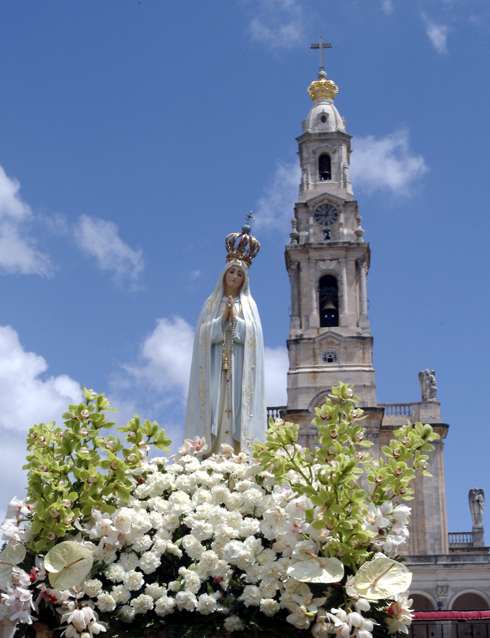 Our Lady Came to Fatima
Our Lady Came to Fatima Our Lady Came to Fatima
Our Lady Came to FatimaOctober 12, 1917 -- what a night it was! It was as if the Devil, somewhere in the ice and snow that could never slake the burning of his pain, had resolved to destroy with one blow all that remained of Catholic Europe which had so long been his battleground against her whom he hated and feared the most, the Woman who crushes the pride of his head. Somewhere in the dark misery of Siberia, he was permitted, Heaven knows why, to disturb the equilibrium of the air, setting in motion a cold and cutting blast that shrieked across the continent to the western sea. It may have passed howling over a cabin in Finland where a little lynx-eyed man who called himself Lenin was waiting to enter St. Petersburg (he had lately sown the seeds of revolution there), and to begin, in a very few weeks, the transformation and destruction of all that entire world, which owed what was best and noblest in it to the teachings of the Only-Begotten Son of God. It screamed in mockery over vast military armaments moving stealthily through Prussia, preparing for one last deadly assault of the Great War. It scourged poor wretches of both armies into the cover of slimy dugouts all along the western front, and plastered with mud the Italian fugitives from Caporetto. It seemed to echo and enlarge the despair that was settling over the vineyards of war-torn France. Finally it dashed itself against the Pyrenees, and then, as if it had gathered up all the hatreds and discontents of disobedient men and all the rebellious powers of a corrupted nature in its mad career from the Baltic to Cape Saint Vincent, it let them all loose on the little Catholic country that had never been permanently conquered, the land where she who treads upon the serpent's head has long been honored, the terra da Santa Maria.
Darkness fell swiftly, with blacker clouds scudding from the northeast, and huge shapeless masses of fog drifting along the mountain sides and down the river valleys to the ocean. As the drizzle thickened to a fine, cold, slanting rain, the wind, whipped to a gale, bent under it the waving and moaning plumes of the pine forests near Leiria; it ripped the square sails of ancient windmills on the gray heights of the Serra; it scattered pale glistening leaves of poplars and aspens across the swollen currents of the river Tagus; it flattened the plucked and reddened vineyards of Braga and the withered gardens of Moita and Fatima; it went roaring across hundreds of miles of narrow beaches until the frothy Atlantic bellowed back in anger, and cast up vengeful floods into village streets. The rain fell steadily, pitilessly.
Yet there were thousands of human beings and many beasts on the roads of the little nation of Portugal that night. For faith is stronger than doubt, and love is hardier than hate. Devout Catholics in every village had heard by this time that Our Lady had promised to return to the Cova da Iria to perform a miracle on October 13th. Rain or shine, that was all they needed to know. Peasant families slung their wicker baskets and earthen water jugs over their shoulders, or packed them in great panniers on the backs of burros, and started out under the lowering skies. Fathers and mothers carried sick or lame children in their arms for incredible distances. Fishermen left their nets and boats on the beaches of the Vieira and took to the oozing roads. Farmhands from Monte Real, sailors from ships in the harbors of Porto or Algarve, factory workers from Lisboa, serranas from Minde or Soublio, ladies and gentlemen, scrubwomen, waiters, young and old, rich and poor, all sorts of people (but most of them humble, most of them barefoot, most of them workers and their families) were plodding through the mud under the pelting rain that night, like a great scattered army converging upon Fatima, hoping to find there some favor of health or conversion, forgiveness of sin, consolation for sorrow, the beginning of a better life, the blessing of the Mother of God.
It made no difference to these devotees if saturated trousers or skirts sloshed around their tired legs as their bare feet plowed through the mud or spattered the puddles of bad roads. Laughter was heard among groups of several families as they walked along together. Fragments of old hymns would echo back from the wet cliffs, or come floating down out of the darkness of a lonely road. "Ave, Ave, Ave Maria!" Not for nothing had the ancestors of these people sung the Salve Regina on the decks of galleons in the Indian Ocean or whalers in the China Sea. It might have been a useful lesson for some of the politicians at Lisboa if they could have heard those songs.
The men of the world were not left wholly uninformed, however. Avelino de Almeida, managing editor of 0 Seculo, the largest secular newspaper in Lisboa, who was on his way to cover the story at Cova da Iria, describes some of the pilgrims he met near Châo de Macas, before the rain began to fall:
"Nearly all, men and women, have bare feet, the women carrying their footgear in bags on their heads, the men leaning on great staves and carefully grasping umbrellas also. One would say they were all oblivious to what was going on about them, with a great lack of interest in the journey and in other travelers, as if lost in a dream, reciting their Rosary in a sad rhythmic chant. A woman says the first part of the Hail Mary; her companions in chorus say the second part of the prayer. With sure and rhythmical steps they tread the dusty road which runs between the pine woods and the olive groves, so that they may arrive before night at the place of the apparition, where, under the serene and cold light of the stars, they hope they can sleep, keeping the first places near the blessed azinheira tree so that today they can see better."
It was not devotion that took the editor of O Seculo to Fatima. Almeida was a Freemason who made no secret of his dislike for priests, Sacraments, creeds and dogmas. He was covering the story because it had been too much talked about to be ignored, and he was one of the best newspaper men in Portugal. His dispatch, published in O Seculo on the morning of October 13th, portrays him as a politely cynical gentleman, one who did not believe but had no wish to hurt or ridicule those who did:
"Thousands of persons are hastening to a wild expanse of country near Ourem to see and hear the Virgin Mary. Let pious souls be not offended and pure believing hearts be not afraid; we have no intention of being a scandal for those who sincerely hold to their faith and whom the miraculous still attracts, seduces, bewitches, consoles and fortifies, as has been the case for thousands of years, and most certainly will be for other thousands of years! . . . This is only a short newspaper article on an event which is not new in the history of Catholicism. . . . Some regard it as a message from Heaven and a grace; others see in it a sign and proof that the spirit of superstition and fanaticism has planted deep roots that it is difficult or even impossible to destroy.
"Times of great calamities have always revived and renewed religious ideas and have favored them. And war, which strikes everywhere, offers them the most favorable and fertile soil for growth. We see that confirmed in the life of the trenches and even in the spiritual atmosphere of the belligerent countries."
After some pointed observations about the speculators who doubtless were waiting to profit by the credulity of the masses, he gave a fair summary of the events at Fatima, and recalled previous apparitions of the Holy Virgin at Lourdes, La Salette, and other places. Then he continued more ironically:
"The miracle takes place between noon and one o'clock, according to those who have been there. But not all have the chance to see the holy figure. The number of the elect seems very small. Despite their efforts, many see nothing. This is why those who find themselves near the children are contented with hearing them speak with an invisible partner. Others, on the contrary, see in a divinely solemn moment the stars shining in the firmament, even though the sun be at the zenith. They hear a subterranean groaning which announces the presence of the Lady. They claim that the temperature falls and they compare the impressions of that moment with those they have experienced during an eclipse of the sun. . .
"According to what the children say, the figure of the Virgin appears on an azinheira, surrounded on all sides by a slight cloud. . . . The suggestion of the masses, brought there by the supernatural and captivated by a superhuman force, is so powerful that eyes fill with tears, faces become as pale as corpses, men and women throw themselves on their knees, chant songs and recite the Rosary together.
"We do not know if there have already been blind persons who have recovered their sight, paralytics who have regained the use of their limbs, hardened sinners who are turned back from the straight ways of sin to plunge into the purifying water of penance.
"But that matters little. The news of the apparitions has spread from Algarve to the Minho. Since the Day of the Ascension the pilgrims have flocked there by thousands on the thirteenth of each month, from near and far. The means of transportation do not suffice.
"The clergy of the place and the neighborhood maintain, as regards the events, a prudent reserve, at least in appearance. It is the custom of the Church. It proclaims loudly that in such circumstances doubt means nothing, for doubts also come from the devil. But secretly it rejoices over the great concourse of pilgrims who since May have become more and more numerous.
"And there are even people who dream of a great and magnificent church, always full, of large hotels near by with every modern comfort, of shops well stocked with a thousand and one different objects of piety and souvenirs of Our Lady of Fatima, and of a railway which will take us to the future miraculous sanctuary with more convenience than the buses in which, for the moment, the mass of the faithful and of the curious now achieve this right. . ."
While the author of these pessimistic observations was making his way to Ourem, and then with deepening discomfort to the Cova da Iria, the Abóbora and Marto families, after a restless night listening to the rain pelting on the tiles, were rising in the cheerless dawn. Indeed, the east was hardly streaked with dismal gray when the first dripping pilgrims came knocking at their doors. Soon there were dozens and scores of them, and they not only surrounded the two cottages, clamoring for a glimpse of the children, but were cheerfully forcing their way inside without waiting to be invited. Jacinta and Francisco's mother, Ti Olimpia, was furious at the casual way they shed puddles of water and red mud from the fields all over her floors. For longer afterwards Ti Marto bantered her on how she fluttered about, trying to get the children ready and at the same time to answer the questions of a jostling mob. It was too much when these strangers began to make themselves comfortable on her beds and chests.
"Get out of here, all of you!" she cried.
The people paid no attention. A few more pushed their way in.
"Leave them alone, woman," advised her husband. "When the house is full, no more will be able to get in."
A neighbor plucked him by the sleeve and said in his ear:
"Ti Marto, you'd better not go to Cova da Iria. They might beat you up. The little ones, no. They are babies, no one is going to hurt them. You are the one in danger of being hurt."
"I'm going openly," returned the other, "and I'm not afraid of anybody. I have no doubt everything will be all right."
Olimpia did not share this confidence. She was praying fervently to Our Lady to protect her and her family that day, and years later she still wondered how her children could have remained so calm and unafraid in the midst of all that confusion.
"If they hurt us," said Jacinta, "we are going to Heaven. But those that hurt us, poor people, are going to Hell."
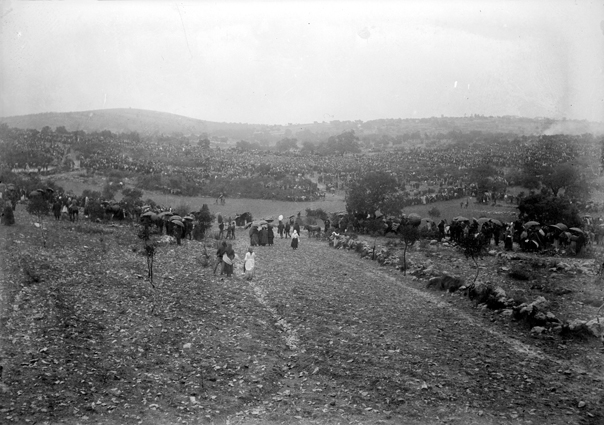 One of the intruders in the house of Ti Marto was a Baroness from Pombalinho, who insisted on presenting two ornate dresses, a blue one for Lucia, a white one for Jacinta. The girls declined these, preferring their own white Communion attire. Finally, after infinite confusion, they managed to get a bite to eat and to squirm out of the house.
One of the intruders in the house of Ti Marto was a Baroness from Pombalinho, who insisted on presenting two ornate dresses, a blue one for Lucia, a white one for Jacinta. The girls declined these, preferring their own white Communion attire. Finally, after infinite confusion, they managed to get a bite to eat and to squirm out of the house.
At the last moment Lucia's mother put on her shawl and said she would accompany them. "I know they are going to kill you," Maria Rosa said tearfully to Lucia. "Very well, then, if you must go, I will go and die with you."
It was a long and slow journey. The highroad was crowded all the way from Fatima to Cova da Iria. Men and women were kneeling in the thick slime on both sides, imploring their prayers. Hands reached out to touch them. Wet burros brushed against them. Umbrellas threatened to poke out their eyes. But what a sight when at last they arrived near the scene of the apparitions! Fully 70,000 men, women and children, people of all ages and conditions, were standing patiently in the rain waiting for them -- a dark mass under innumerable black umbrellas, dripping sombreros, soaked blankets. They were packed so densely between the highway and the azinheira that the children were able to get through only with the help of a chauffeur, who seized Jacinta and mounted her on his shoulder, crying, "Make way for the children who saw Our Lady!"
Ti Marto followed with Lucia and Francisco. When they reached the place of the apparitions, he was surprised to find his wife already there. He had forgotten her in his anxiety for Jacinta. "My Olimpia turned up from another direction, I don't know from where," he confesses.
At all events there she was close to the stump of the azinheira, which Maria Carreira had lovingly draped, along with her alms table, under garlands of flowers. The crowd lurched and swayed this way and that, ducked umbrellas, huddled together for warmth, scanned the leaden eastern sky. Loud voices were repeating the Rosary in various rhythmical cadences. A priest who had been praying all night in the rain and mud was reading his breviary and from time to time nervously fingering his watch. Presently he turned to the children and asked at what hour Our Lady was going to arrive.
"At midday," replied Lucia.
He glanced at his watch again, and said, disapprovingly:
"It is midday already. Our Lady is not a liar. We shall see." Nearly all the people now were saying the Rosary. "Ave, Maria, cheia de graca. . . Santa Maria, Mãi de Deus, rogai por nos pecadores. . ."
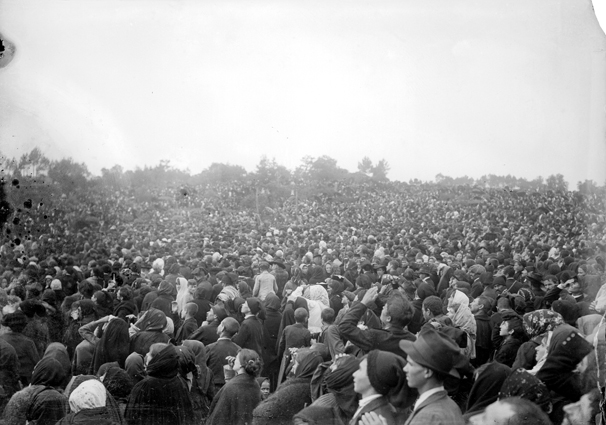 "Put down your umbrellas!" cried Lucia -- why she never knew -- and one after another they obeyed, although the rain was still falling. "Put down your umbrellas!" said one after another. They all stood patiently in the rain.
"Put down your umbrellas!" cried Lucia -- why she never knew -- and one after another they obeyed, although the rain was still falling. "Put down your umbrellas!" said one after another. They all stood patiently in the rain.
A few minutes more passed. The priest looked at his watch again.
"Midday is past," he said with gloomy finality. "Away with all this! It is all an illusion."
He began to push the three children with his hands, if we may trust the memory of Maria Carreira. But Lucia, almost in tears, refused to budge, saying:
"Whoever wants to go, can go, but I'm not going. Our Lady told us to come. We saw her other times and we're going to see her now."
Disappointed murmurs and grumblings began to be heard among the bystanders. Then suddenly Lucia looked toward the east and cried:
"Jacinta, kneel down, for now I see Our Lady there. I can see the flash!"
"Watch out, daughter!" It was the shrill voice of Maria Rosa. "Don't let yourself be deceived!"
Lucia did not hear the warning. Those near her noticed that her face had become flushed and transparently beautiful. She was gazing rapturously now at the Lady herself, who stood in a flood of white light on the flowers that Maria Carreira had draped on the stump of the azinheira. Jacinta and Francisco, on either side of her, stared likewise, both radiant, both quite oblivious of the multitude around them.
"What do you want of me?" Lucia was kneeling with the others. The fine rain fell on her upturned face.
"I want to tell you to have them build a chapel here in my honor. I am the Lady of the Rosary. Let them continue to say the Rosary every day. The war is going to end, and the soldiers will soon return to their homes."
"I have many things to ask of you," said Lucia. "The cure of some sick persons, the conversion of some sinners. . .
"Some yes, others no. It is necessary that they amend their lives, and ask pardon for their sins."
Her face became graver as she continued, "Let them offend Our Lord God no more, for He is already much offended."
With this the Lady of the Rosary opened her white hands as always, and it seemed to Lucia that the light emerging from them ascended to where the sun ought to be, directly overhead, and it was brighter than any sunlight. Perhaps it was at this moment that the crowd saw the clouds separate like two vast curtains rolled apart, and the sun appear between them in the clear blue, like a disk of white fire. Certainly many heard Lucia cry, "Look at the sun!" but she said this in ecstasy and had no recollection of it later. For she was wholly absorbed in something she saw where the sun must have been.
As Our Lady disappeared in the very radiance that came from her outstretched hands, there stood out in the zenith above three tableaus which symbolized, one after another, the Joyous, the Sorrowful and the Glorious mysteries of the Rosary. The first was a distinct representation of the Holy Family: Our Lady herself in her traditional dress of white with a blue mantle, and Saint Joseph beside her holding the Child Jesus on his arm -- Saint Joseph in white, the Infant in bright red.
Lucia was heard to say, "Saint Joseph is going to bless us!"
All three of the children saw this first vision, and saw the Saint make the sign of the cross three times over the crowd. The holy Child did likewise.
The next vision, seen by Lucia alone, was one of Our Lady of Sorrows in the sombre garb assigned to her by tradition, the Mater Dolorosa of Good Friday, but without the sword in her breast; and beside her stood her Divine Son grieving as when he met her on the way to Calvary. Lucia saw only the upper part of His figure. He looked pityingly on the crowd for whom He had died, and raised His Hand to make the Sign of the Cross over them.
Our Lady then appeared in a third vision of glory, as Our Lady of Mount Carmel, crowned as the Queen of Heaven and of the world, her infant Son upon her knee.
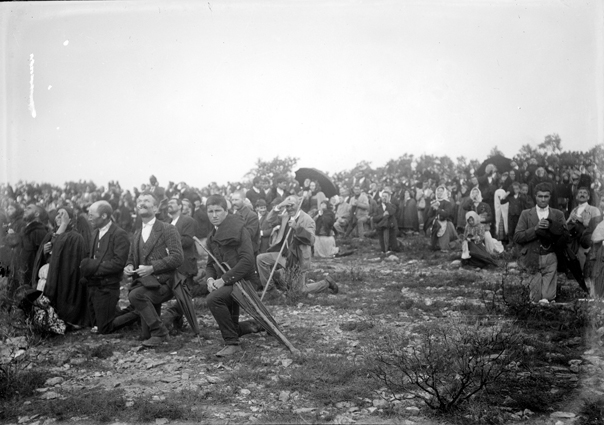 The crowd saw nothing of all this: at least there seems to be no solid verification of the claim that a few saw the Lady. What they all did see, however, was something stupendous, unheard of, almost apocalyptic. The sun stood forth in the clear zenith like a great silver disk which, though bright as any sun they had ever seen, they could look straight at without blinking, and with a unique and delightful satisfaction. This lasted but a moment. While they gazed, the huge ball began to "dance" -- that was the word all the beholders applied to it. Now it was whirling rapidly like a gigantic fire-wheel. After doing this for some time, it stopped. Then it rotated again, with dizzy, sickening speed. Finally there appeared on the rim a border of crimson, which flung across the sky, as from a hellish vortex, blood-red streamers of flame, reflecting to the earth, to the trees and shrubs, to the upturned faces and the clothes all sorts of brilliant colors in succession: green, red, orange, blue, violet, the whole spectrum in fact. Madly gyrating in this manner three times, the fiery orb seemed to tremble, to shudder, and then to plunge precipitately, in a mighty zigzag, toward the crowd.
The crowd saw nothing of all this: at least there seems to be no solid verification of the claim that a few saw the Lady. What they all did see, however, was something stupendous, unheard of, almost apocalyptic. The sun stood forth in the clear zenith like a great silver disk which, though bright as any sun they had ever seen, they could look straight at without blinking, and with a unique and delightful satisfaction. This lasted but a moment. While they gazed, the huge ball began to "dance" -- that was the word all the beholders applied to it. Now it was whirling rapidly like a gigantic fire-wheel. After doing this for some time, it stopped. Then it rotated again, with dizzy, sickening speed. Finally there appeared on the rim a border of crimson, which flung across the sky, as from a hellish vortex, blood-red streamers of flame, reflecting to the earth, to the trees and shrubs, to the upturned faces and the clothes all sorts of brilliant colors in succession: green, red, orange, blue, violet, the whole spectrum in fact. Madly gyrating in this manner three times, the fiery orb seemed to tremble, to shudder, and then to plunge precipitately, in a mighty zigzag, toward the crowd.
A fearful cry broke from the lips of thousands of terrified persons as they fell upon their knees, thinking the end of the world had come. Some said that the air became warmer at that instant; they would not have been surprised if everything about them had burst into flames, enveloping and consuming them.
"Ai Jesus, we are all going to die here!"
"Save us, Jesus! Our Lady, save us!"
"Oh, my God, I am sorry..." And one began the Act of Contrition.
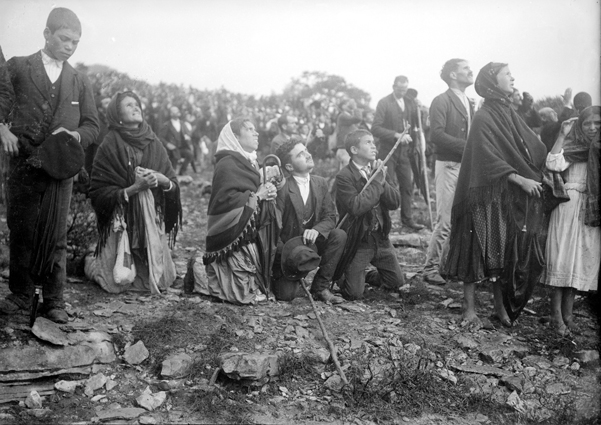 Some who had come to jeer fell on their faces and broke into sobs and abject prayers.
Some who had come to jeer fell on their faces and broke into sobs and abject prayers.
The Marques do Cruz said, "Oh my God, how great is Thy power!"
This had lasted about ten minutes, perhaps. Then all saw the sun begin to climb, in the same zigzag manner, to where it had appeared before. It became tranquil, then dazzling. No one could look at it any longer. It was the sun of every day.
The people stared at one another in joy and amazement. "Miracle! Miracle! The children were right! Our Lady made the miracle! Blessed be God! Blessed be Our Lady!" The shouts were taken up all over the Cova da Iria. Some were laughing, others weeping with joy. Many were making the discovery that their drenched clothes had in some unexplained manner become perfectly dry.
Avelino de Almeida reported the event in O Seculo of October 17 as "a spectacle unique and incredible if one had not been a witness of it… One can see the immense crowd turn toward the sun, which reveals itself free of the clouds in full noon. The great star of day makes one think of a silver plaque, and it is possible to look straight at it without the least discomfort. It does not burn, it does not blind. It might be like an eclipse. But now bursts forth a colossal clamor, and we hear the nearest spectators crying, 'Miracle, miracle! Marvel, marvel!'
"Before the astonished eyes of the people, whose attitude carries us back to biblical times and who, full of terror, heads uncovered, gaze into the blue of the sky, the sun has trembled, and the sun has made some brusque movements, unprecedented and outside of all cosmic laws -- the sun has 'danced,' according to the typical expression of the peasants. . . An old man whose stature and face, at once gentle and energetic, recall those of Paul Deroulède, turns toward the sun and recites the Credo with loud cries from beginning to end. I ask his name. It is Senhor Joao Maria Amado de Melo Ramaiho da Cunha Vasconcelos. I see him afterwards addressing those about him who have kept their hats on, begging them vehemently to uncover before so extraordinary a demonstration of the existence of God. Similar scenes are repeated in all places.
"The people ask one another if they have seen anything and what they have seen. The greatest number avow that they have seen the trembling and dancing of the sun. Others, however, declare that they have seen the smiling face of the Virgin herself; swear that the sun turned around on itself like a wheel of fireworks; that it fell, almost to the point of burning the earth with its rays. . . . Another tells that he has seen it change color successively. . .
"Almost three o'clock. The sky is limpid and the sun follows its course with its habitual brilliancy so that no one dares to look at it directly. And the shepherds? . . . Lucia, the one who speaks to the Virgin, announces with theatrical motions, on the neck of a man who carries her from group to group, that the war is going to end and that the soldiers are coming home. Such news, however, does not increase the joy of those who hear her. The celestial Sign, that is everything. Much curiosity, nevertheless, to see the two little girls with their garlands of roses; some try to kiss the hand of the 'little saints'; and one of the two, Jacinta, is much nearer to fainting than to dancing. But what all aspired for -- the Sign in the Sky -- has sufficed to satisfy them, to enroot them in their Breton-like faith…
"Their dispersion follows rapidly and without incidents, without the shadow of disorder, without the need of any intervention of police patrols. The pilgrims who leave first, in haste to be on their way, are those who arrived first with their shoes on their heads or hung on their staves. They are going, their souls full of joy, to spread the good news in the villages that were not wholly depopulated to come here. And the priests? Some have shown themselves on the scene, standing rather with the curious spectators than in the company of pilgrims avid for celestial favors. Perhaps now and then one does not manage to conceal the satisfaction which appears so often on the faces of those who triumph. . . . It remains for those competent to pronounce on the danse macabre of the sun, which today, at Fatima, has made hosannas burst from the breasts of the faithful and naturally has impressed -- so witnesses worthy of belief assure me -- even freethinkers and other persons not at all interested in religious matters who have come to this once famous countryside."
All over Portugal, in fact, the anti-clerical press was compelled to bear witness of the same sort. There was general agreement on the essentials. As Dr. Domingos Pinto Coelho wrote in 0 Ordem, "The sun, sometimes surrounded with crimson flames, at other times aureoled with yellow and red, at still other times seemed to revolve with a very rapid movement of rotation, still again seeming to detach itself from the sky, to approach the earth and to radiate strong heat."
Theories of mass hypnotism or suggestion were discarded when it became known that reliable witnesses not in the crowd had seen the miracle many miles away. The poet Afonso Lopes Vieira saw it from his house at S. Pedro de Moel, forty kilometers from Fatima. Father Inacio Lourenco told later how he had seen it from Alburita, eighteen or nineteen kilometers away, when he was a boy of nine. He and some fellow students heard people shouting in the street near by. Running out of the school with his teacher, Dona Delfina Pereira Lopes, he saw with amazement the spinning and falling of the sun:
"It was like a globe of snow revolving on itself," he wrote. "Then suddenly it seemed to come down in a zigzag, threatening to fall on the earth. Terrified, I ran to shelter myself in the midst of the people. All were weeping, expecting from one moment to the next the end of the world.
"Near us was an unbeliever without religion, who had spent the morning mocking the 'blockheads' who had made all that journey to Fatima to go and stare at a girl. I looked at him. He stood as if paralyzed, thunderstruck, his eyes fixed on the sun. Then I saw him tremble from head to foot, and raising his hands to heaven, he fell on his knees in the mire, shouting, 'Nossa Senhora! Nossa Senhora!'
"Meanwhile the people continued to scream and cry out, begging God to pardon their sins... Afterwards we ran to the chapels of the town, which were filled in a few moments.
"During those long minutes of the solar phenomenon objects all about us reflected all the colors of the rainbow. As we looked at one another, one seemed blue, another yellow, another vermilion... All these strange phenomena increased the terror of the crowd. After about ten minutes the sun returned to its place in the same way it had descended, still pale and without splendor..."
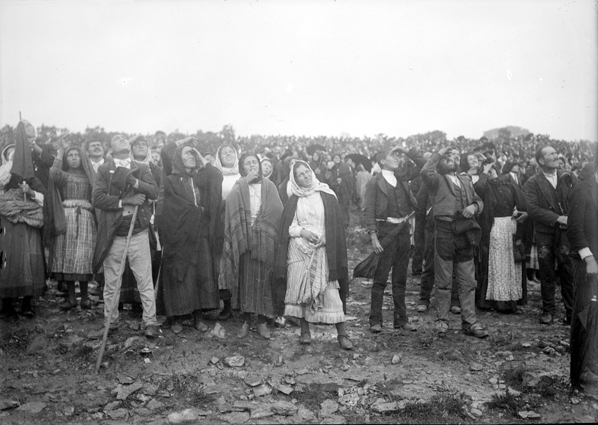 Plenty of witnesses are still living in the neighborhood. I spoke with many of them last summer (1946), including Ti Marto and his Olimpia, Maria Carreira, two of the sisters of Lucia (Maria of the Angels and Gloria) and several others of the country folk, all of whom told the same story with evident sincerity; and as they mentioned the falling of the sun, there was always a trace of terror in their voices. The Reverend Father Manuel Pereira da Silva gave me substantially the same details. "When I saw the sun fall zigzag," he said, "I fell on my knees. I thought the end of the world had come."
Plenty of witnesses are still living in the neighborhood. I spoke with many of them last summer (1946), including Ti Marto and his Olimpia, Maria Carreira, two of the sisters of Lucia (Maria of the Angels and Gloria) and several others of the country folk, all of whom told the same story with evident sincerity; and as they mentioned the falling of the sun, there was always a trace of terror in their voices. The Reverend Father Manuel Pereira da Silva gave me substantially the same details. "When I saw the sun fall zigzag," he said, "I fell on my knees. I thought the end of the world had come."
The fact has been established beyond any doubt. How is it to be explained?
As early as May, 1917, Jacinta and Lucia had told people that the Lady they saw had promised a miracle on October 13, at the hour of noon, as a sign of their sincerity. They had repeated this at various times, and had never altered their story even under threats and persecution which must have been terrifying to such children at the ages of ten, nine, and seven. On the very day and hour they had foretold, some 70,000 persons testified that they had the unique experience of seeing the sun spin round and seem to fall. Such widespread testimony serves to confirm that the children actually had seen the Mother of Christ, and that He had given to the simple souls at Cova da Iria the sign in the sky for which the Pharisees had begged Him in mock reverence, and which He had refused to grant their unbelieving and adulterous hearts.
The obstinate Administrator of Ourem still denies that anything miraculous happened. I suspect he would have denied it even if he had been there. Or like the Pharisees who denied the Resurrection after they had seen Christ dying on the cross, he would have made up some rationalistic explanation to save himself the humiliation of believing.
Arturo de Oliveira Santos was removed from office following the coup d'etat of Sidonio Païs some two months after the miracle. The last heard of him was that he was injured in Tomar by the premature explosion of a bomb he was making to throw at certain members of the new government.
Visit also: www.marienfried.com